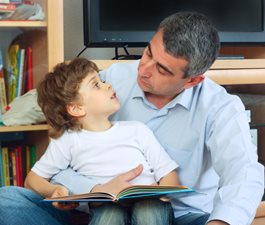Make Book Reading a Time for Conversations

Brittany Da Silva
Clinical Program Assistant, The Hanen Centre

In your child’s favorite book, what does he like to talk about?
When you talk about topics that have captured your child’s interest in books, it helps develop his language and literacy skills.
This article will:
- Talk about why it’s important to make book reading a time for interaction and conversation
- Provide you with videos that show the difference between reading with and without interacting
- Give you strategies and tips you can use with your child to make book reading interactive
When you talk about topics that have captured your child’s interest in books, it helps develop his language and literacy skills.
Why is it important to make book reading interactive?
Research has shown that when children are engaged in conversations while reading books, we see growth in their:
- Understanding of what’s read
- Language skills, including the number of words they know and say
- Reading abilities when they’re older [1,2]
Children benefit from interactive book reading because they:
- Are more engaged when they play an active role and talk about their interests
- Are introduced to new ideas and more advanced language that they don’t hear in everyday conversations, such as:
- New and interesting words (which has a great impact on reading skills later on!)
- Complex sentences
- Can connect new information to what they already know
- Are exposed to the building blocks of literacy. These building blocks are the knowledge and skills that children learn before they start to read and write, like:
- Understanding and using new words
- Story structure
- What the writer means but hasn’t specifically stated [2]
What does reading with vs. without interacting look like?
Here are two video clips of a mom, named Jill, and her son, Liam. Watch the first clip and consider if Jill and Liam are interacting while they read or not.
In the first clip, Jill read the book to Liam and they did not interact with each other.
Watch the second clip and see how Jill has changed the way she reads the book and think about the impact it has on Liam.
In the second clip, Jill interacted with Liam while reading the book. We saw Jill make comments and ask questions about Liam’s interests. She also waited before turning a page. When Jill talked about Liam’s interests and waited, this gave Liam the chance to make comments and ask questions too.
Jill talked about ideas that went beyond what was in the pictures or directly stated in the book. For example, Jill and Liam used language to explain why the witch had such a tall hat (so all of her hair would fit inside!). They also used problem-solving skills to discuss what might happen if the witch wore a smaller hat (it might stay on and not be blown away in the wind!).
When they had conversations about the book, Liam benefited because he understood the story better. He was also exposed to more advanced language that involved explaining and problem-solving.
Hanen strategies that will help you make book reading interactive!
Observe, Wait and Listen (OWL)
Observing, Waiting and Listening to your child’s messages is a powerful strategy because it gives you information about what your child is interested in, lets him start and lead the interaction and makes him feel heard. When you’re reading together, here’s how you can OWL:
| Observe |
- What your child reacts to
- What interests him
|
| Wait |
- Stop speaking
- Look expectantly at your child
|
| Listen |
- Pay close attention to what your child is telling you
|
It can be helpful to plan when you’re going to OWL. Here are some good options for when you can OWL:
- Before or after you turn the page
- After you make a comment about something in the story
- After you point to and comment on a picture
- When something exciting happens in the book
- After you ask a question [2]
In your child’s favorite book, when might you try OWLing?
Follow Your Child’s Lead
After your child starts an interaction with you, respond immediately! You can respond by saying something that relates to what your child has just said or done. Just like Jill explained an idea or talked about solving a problem, you can go beyond what is written or illustrated in the book. It can be fun and even surprising to see where your conversations go!
Here are some tips for how you can follow your child’s lead in books:
- Respond warmly and enthusiastically to what he says or does. Make a comment or ask question about what he said or did
- Let him set the pace
- Point to what he is pointing to and talk about it
- Spend more time on pages he really likes [2]
Can you think of a page that your child may want to spend more time on? What might he do to show you that he’s interested in staying on that page?
As we saw with Jill and Liam, book reading is a great time to have conversations that build your child’s language and literacy skills. To turn book reading into a time for conversation, let your child lead the interaction by OWLing and then follow your child’s lead by responding to his messages. We hope you have fun interacting with your child while reading books together!
References
- National Early Literacy Panel (2008). Developing Early Literacy: Report of the National Early Literacy Panel. Washington, DC: National Institute for Literacy.
- Greenberg, J. & Weitzman, E. (2014). I’m Ready! ™ How to Prepare Your Child for Reading Success. Toronto: The Hanen Centre.